Have you ever sat beneath an old urban tree and wished that it could talk? Many times older than any human, yet always rooted to one location, imagine the stories that the tree could share and the wisdom it could impart. Such trees could have led extraordinary lives, witnessing profound landscape transformations: from natural to rural to urban; from residential to industrial to commercial.
Why do they stand where they do? Did somebody plant them, and if so, for what purpose? What history occurred beneath their branches? Were battles waged, was power brokered, were treaties signed, were enterprises born, were slaves sold, and convicts hung? What human tragedy, scandal, and elation, have these trees beheld? Moreover, why have they survived so long, when all about them is changing?
Interesting trees can be found in almost any city. They can shed light on the cultural value systems and economic priorities of bygone generations. If approached with an inquisitive mind, these trees provide excellent starting points for journeys of learning about a city — journeys that have no fixed route or endpoint. Over time, the trees and their environs develop distinctive personalities, reflected in the various anecdotes that we attach to them. This makes for an altogether more interesting and enriching urban landscape.
So far, I have identified over 30 remarkable trees in the City of Cape Town, South Africa. These trees have captured my imagination and led me to better understand and appreciate the colourful culture and rich, if brutal, history of the city. Here follows a small selection.
(1) The Treaty Tree in Woodstock
On Treaty Road, about 2 km east of the city centre, in the post-industrial suburb of Woodstock, there stands an ancient milkwood (Sideroxylon inerme), known as ‘The Treaty Tree’, which is well over 500 years old.
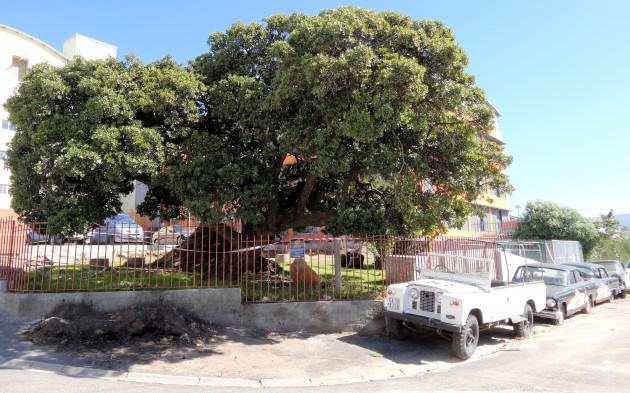
It was here on Cape Town’s original beachfront, in 1510, that the famous Portuguese explorer, Dom Francisco de Almeida, and 64 of his finest men met a gruesome end. A band of enraged Khoekhoe (local indigenous people) armed with sticks attacked and slaughtered the Portuguese, revenging cattle raids, abductions and extortion.
In later centuries, the tee became known as the Old Slave Tree of Woodstock. Under its shady breadth, slave masters bartered away humans like livestock, and from its gnarled branches, numerous “disobedient” slaves were hung.
In the early 19th Century the tree was renamed, The Treaty Tree, to commemorate the start of the second British occupation of the Cape. It was here, following the Battle of Blaauwberg in 1806, that the victorious British Forces regrouped and the defeated commander of the Dutch (Batavian) Forces signed capitulation conditions, effectively transferring control of the Cape to Britain. Different sources contest whether the treaty was signed underneath the tree or in an adjacent cottage later named Treaty House. However, the latter was demolished in 1935 to make way for a factory, so today, only the Treaty Tree remains and it is now protected as a National Monument.
The historical significance of The Treaty Tree is not reflected in its upkeep. Tall neighbouring buildings crowd it from view. Abandoned, stripped, and rusting old cars line along Treaty Road. Dozens of colourful plastic bags are tangled like tinsel in its branches. Remnant glue on a flat-faced rock suggests that the only information plaque has been stolen.
(2) European Oak in Groot Constantia
This European oak tree (Quercus robur) is several centuries old and remarkably hollow. Presumably it suffered from a fungal disease, perhaps after being struck by lightning or split by violent wind. Appearing at odds with gravity, its thick heavy branches hang precariously on the trunk’s thin, empty exoskeleton.

This oak tree is one of many found on Groot Constantia, South Africa’s oldest wine estate. In 1685, the Dutch East India Company (VOC) granted the land to Simon van der Stel, the Governor of the Cape of Good Hope and an avid wine-lover. Van der Stel recruited French winemakers to the colony, who with the assistance of slaves, established vineyards in Constantia Valley, now suburban Cape Town. Rows of oak trees were planted to shield the vineyards from the beating winds of the ‘Cape Doctor’ and to provide wood for making wine barrels. This latter function will have been limited, because oaks tend to grow quickly in the Cape, rendering only low-quality, porous wood. In any case, the wine of Constantia soon became widely admired, especially the desert wine, Vin de Constance, famously a favourite of Napoleon Bonaparte when in exile on the island of St Helena.
From the affluent vantage point of the old hollow oak tree, one has a panoramic view of False Bay, called so because sailors returning from the East would mistake it for Table Bay further up the coastline. To the south, the Cape Peninsula skirts high above the surfing town of Muizenberg, and to the north, one can see part of the Cape Flats, known as ‘apartheid’s dumping ground’.
(3) Saffron Pear in the Company’s Garden
Of the many old trees in the centre of Cape Town, the saffron pear (Pyrus communis) in the Company’s Garden could be the oldest. Brought here from Holland during the time of Jan van Riebeeck (the founder of Cape Town) some 350 years ago, it is probably also South Africa’s oldest living cultivated tree. Three suckers radiate from the main trunk which died back many years ago. The rot has been scraped away and special sealant applied. Metal crutches and cables now hold the tree in place. Astonishingly, it still produces clusters of white flowers every spring and a bounty of edible fruit every autumn. It must be a surreal experience to taste the fruit of the same tree from which the traveller, Valentyn, recorded eating in 1714!
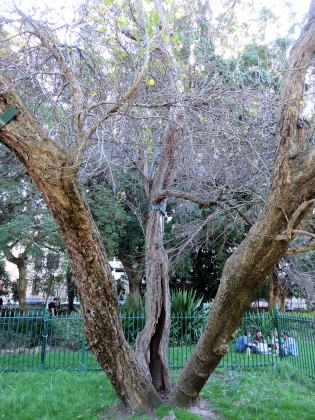
Established by the VOC in 1652, when indigenous hunter-gatherers and migratory pastoralists still roamed the land, the Company’s Garden is a foundation stone of Western colonisation of Africa. The Dutch needed a victualing station to provide fresh supplies to sailing ships plying the spice trade between the East and Europe, and later, to support ships engaged in foreign wars. To this end, the Company’s Garden was designed primarily to produce food. One can still see evidence of the original irrigation furrows and wells.
Today, the Company’s Garden provides Capetonians with a well-used refuge in the busy city centre. This green oasis brims with fascinating plants, statues and monuments, and abuts several historic buildings, thereby presenting an ideal gateway to discover the city.
(4) European Oak in the Company’s Garden
Another fascinating European oak tree can be found next to a well, dated 1842, in the Company’s Garden. The tree is remarkable because it has somehow engulfed the well pump and lifted it up to head height such that a large tap, also dated 1842, now protrudes from the trunk.

The well was constructed with alternate rings of wood, slate, and brick to allow for the percolation of groundwater, whilst the base is lined with impermeable clay.
Water has played an essential role in the development of Cape Town. In the ancient Khoisan tongue, the area was known as ‘Camissa’, meaning ‘the place of sweet waters’. It is the existence of this freshwater running cleanly from the slopes of Table Mountain that ultimately determined the site of the city.
The Dutch utilised this water by building various irrigation furrows and canals. Later, in the context of increasing water consumption and periods of severe drought, the British filled in these canals and constructed a system of pipes and sewers, with a view to improving water supply and sanitation. Prevailing street names including the word, ‘gracht’ (e.g. Heerengracht and Buitengracht), reveal the whereabouts of original canals and forgotten waters still flow under these streets. A movement to make better use of this valuable water resource is now underway, spearheaded by the campaign group, Reclaim Camissa.
(5) Black Mulberry in the Company’s Garden
One can also find a contorted black mulberry tree (Morus nigra) in the Company’s Garden. This species, which is native to Persia, was cultivated across much of the old world, partly for its sweet fruit and partly for its leaves which are eaten by silkworms (Bombyx mon) — a clue to the story of the tree in question.
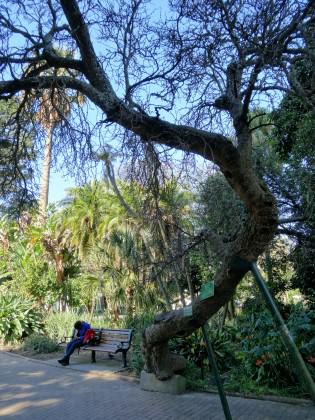
In 1704, Willem Adrain van der Stel, who succeeded his father, Simon, to become Governor of the Cape, sought to establish a local silk industry. ‘Die Oude Spinnery’ (the old spinning factory) was constructed on present-day Spin Street, next to the Company’s Garden. Imported silkworms fed on the leaves of black mulberry trees cultivated in the garden, and slave children were tasked with unspinning their cocoons. The black mulberry tree in the garden dates to 1800 and is probably the offspring of one planted earlier in support of the silk industry.
The industry failed to prosper and was soon abandoned. One account suggests that the eggs of the imported silkworms did not survive well in the Cape, perhaps owing to the harsh climate. Another possible explanation is that silkworms survive poorly on black mulberry, and actually favour white mulberry (Morus alba). Sensing a threat to their commerce, could Eastern silk producers have deliberately provided the Dutch with seeds of the less suitable species?
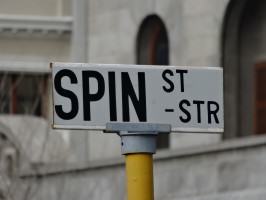
Many years later in 1753, the Frenchman, Francois Guillaumet, unsuccessfully sought to re-establish silk production. Thereafter, the old spinning factory was converted into a grain depot before it burnt down in 1792, leaving only the street name and black mulberry as evidence of Cape Town’s short-lived silk industry.
(6) The Old Slave Tree on Spin Street
Silk aside, Spin Street has a deeply sinister history. An old fir tree, the exact species of which could not be determined, stood here for hundreds of years until 1916 when it was cut down. Under this tree, an estimated 100,000 souls were sold into slavery.
Today, in the absence of that tree, a raised octagonal plaque lies wedged on a traffic island. It is faintly inscribed with the words, “On this spot stood the old slave tree”, which are only legible when the sun hangs low. Pedestrians seem largely unaware of the historical significance of this marker, and sometime walk directly over it when rushing across the street.

Slaves were brought to the Cape from other parts of Africa, India and Indonesia from 1656 onwards. They were named by their masters after months of the year, or characters from the Bible and classical mythology. Their surnames were replaced by their country of origin.
Near to the slave tree plaque is the Slave Lodge, which was built in 1679 and eventually housed 1000 slaves. Having served temporarily as the Supreme Court, the building is a now a museum providing a tear-jerking account of slavery in the region. Visitors can still see the squalid, inhumane conditions in which the slaves were kept. It was not until the 1830s, almost two centuries later, that slaves were finally emancipated.
The inconspicuousness of the slave tree plaque is partially compensated by ‘The Cape Town Memorial to the Enslaved’, unveiled in 2008, in the adjacent Church Square. The memorial comprises a sombre arrangement of eleven blocks of black granite. Each block is engraved with evocative words depicting the names and experiences of slaves.
(7) The Stone Pines of Groote Schuur Estate
Driving into Cape Town along the main freeway, one can see zebra and black wildebeest grazing in grassy paddocks next to massive stone pines (Pinus pinea) afore the crags of Devil’s Peak. The scene is Groote Schuur Estate, and contrasts strikingly with the concrete jungle on the lower side of the freeway.
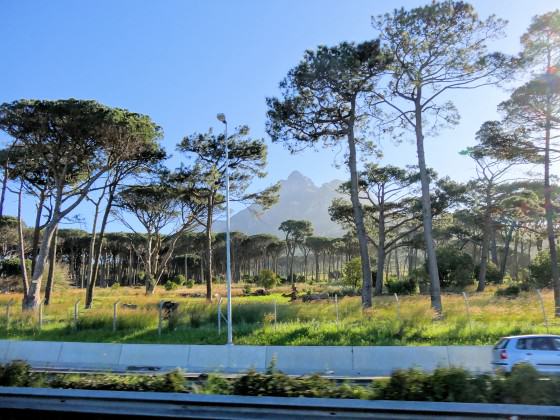
Stone pines are native to the Mediterranean region and have long, branchless trunks terminating in an umbrella-shaped crown. In Cape Town, the trees often grow at an angle owing to the harsh south-easterly wind. Their cones produce large edible kernels known locally as ‘dennepitjies’ (pronounced denna-pye-kees). Many are over 150 years old and have become regarded as an important part of Cape Town’s landscape and heritage, popular for recreational activities and family ‘braais’ (barbeques). However, the pines are extremely water thirsty and corrode native biodiversity. As such, conservation authorities are at pains to remove them and prevent their regeneration, often in the face of strong public opposition.

The stone pines were originally planted by the Dutch in the 1700s, in response to escalating demand for timber. Later, in the 1890s another wave of planting was conducted, this time at the behest of the controversial British imperialist and owner of Groote Schuur Estate, Cecil John Rhodes (1853-1902). It is these pines which can be seen from the freeway today.
Rhodes actually introduced many alien species to the Cape, some of which have become invasive, wreaking ecological havoc. He augmented the diverse stock of African animals kept on Groote Schuur Estate, with llama from Peru and emu, wallaby, and kangaroo from Australia. This folly of nature resulted in overgrazing and land degradation, for which Rhodes has been criticised. However, he has also been rightly credited for preventing this expanse of prime land from being consumed by urbanisation.

In his will, Rhodes bequeathed Groote Schuur Estate to the nation under strict conditions: that it would be used exclusively for public purposes; that any new buildings would be in architectural harmony with the existing buildings; and that the land would not be sold or developed into a residential area. The conditions have been interpreted flexibly over the ensuing years, allowing for two landmark constructions — namely the University of Cape Town in 1920 and the Groote Schuur Hospital in 1938 (made famous by Dr Christiaan Barnard, who conducted the world’s first heart transplant there in 1967) as well as the aforementioned freeway — to infringe on the Estate.
(8) The Silvertree of Table Mountain
The silvertree (Leucadendron argentium) is an endangered species native to the Western Cape fynbos biome. Its silky leaves are covered in fine hairs that shimmer in the sunlight like shards of mirror. A member of Protea family, it only occurs in a few discrete locations on the sunny slopes of Table Mountain, specifically, Kirstenbosch, Newlands and Lion’s Head, where the soils are well-drained and acidic. The tree was once widespread around Table Mountain but urban sprawl, demand for timber, inappropriate fire management, and the spread of invasive alien species, have reduced its range by three-quarters. So precarious is the species’ survival, that a single fire in 2006 destroyed almost half of the world’s entire wild population. Fortunately, the species actually requires fire to regenerate and the population has already recovered to pre-2006 levels.


The silvertree holds a special place in Khoisan folklore. It is said that God asked the birds, animals, and Khoisan people, to plant special seeds which he gave to them. The birds planted the seeds in the centre of the land but they would not germinate because it was too high and cold. The animals planted the seeds on the West coast but they too would not germinate, because it was too dry. The Khoisan headed southwards to plant the seeds. On route, they encountered a great flat mountain (Table Mountain), and in an excited frenzy, spilled the seeds on its sandy slopes. The seeds germinated and grew into trees that shimmered silver to express their glee.
The silvertree also holds a place in modern folklore. Some say that the leaves will only turn silver if the tree has an unobstructed view of Table Mountain. Others say that the leaves turn especially silver when rain is imminent.
Almost all of the history that I have alluded to in this post can be found in museums, books, city archives and specialist websites. However, there are also personal histories that we as individuals can associate with certain trees. For example, on a recent hike through Newlands Forest one of my most spiritually-alert friends stopped abruptly to explain the significance of a large silvertree branching across our path. It was to this place, that some months earlier, she had carried her deceased, beloved cat to bury it in the fynbos. Unable to bring herself to let go, she slumped against the large silvertree and sobbed. Then, in the corner of her eye, she glimpsed a Cape Robin (Cossypha caffra) boldly perching nearby. They looked directly at each other before the robin fluttered away into the thickets. Perceiving it as a sign, she pursued the robin far off the beaten path, until she found it once more, resting on another silvertree. It is there that she chose to bury her cat.
To be continued…
There are far too many fascinating trees in Cape Town, to cover in this post alone.
Russell Galt
Cape Town




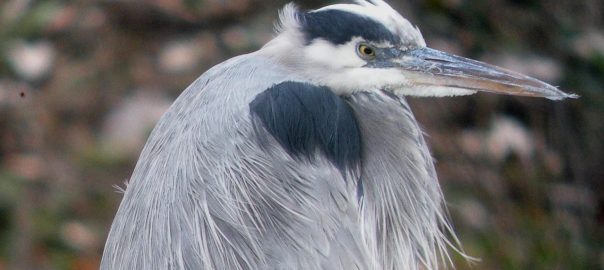


Leave a Reply